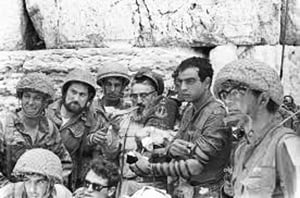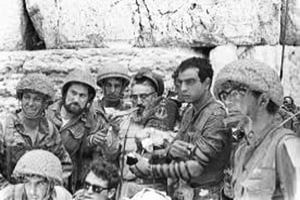
In 1948 we gained independence and returned home after an excruciating absence of 2,000 years. However, the victory was inconclusive: We settled into a hollowed-out country, gouged out of its heartland, and wrung from its historical capital.
But 1967 felt entirely different. The miracles, the military triumph and, most of all, walking through those stony gates—it all felt different, almost biblical. So much of what occurred in 1967 felt familiar—as if it had occurred before. Truth is, 1967 did occur before. Jewish history is cyclical, and its patterns repeat themselves. As a landmark of Jewish history, 1967 returned us to our past.
We Stood Alone
Our return to our greater homeland in 1948 was piloted by international approval and affirmed by UN resolutions. After 2,000 years of endless persecution and discrimination, capped off by the horrors of the Holocaust, it seemed “proper” that the world assist us in returning to our national roots. 1948 was an international project.
In stark contrast, in 1967 we stood entirely alone, with no allies nor with any partners. General Nasser of Egypt, beating the drums of war, threatened to hurl the Jews into the sea. Twenty years after the Holocaust his threat resonated with terror. The United States refused to come to Israel’s aid. Only after 1967 did they begin to “arm” the Jewish state. We stood isolated and alone, facing both multiple armies and the real threat of extinction.
Such it is when Jews ascend the mountain of God. We go it alone. Avraham had traversed the entire topography of Israel, meeting with kings, shepherds, farmers and legal negotiators. Slowly but surely his presence in Israel became a regional consensus. Toward the end of his life, however, he finally ascended to the akeida and to the mountain of Yerushalayim—alone. He specifically instructed his entourage to remain behind with the donkeys, while he scaled the cloud-laden mountain.
Standing alone on this mountain capped his career as Avraham ha’ivri—the man who stood alone on “the other side,” defying paganism and educating a world muddled by confusion and chaos. Being the world’s conscience and its moral spirit can sometimes feel lonely. We aren’t always embraced with open arms. Yet, we continue to stand bold and undeterred. In 1967 we finally assumed this heritage of Avraham; we stood alone as we entered our city.
Mesirut Nefesh
Finally, after all that waiting, in 1967 we stood at the door of Yerushalayim and at the doorstep of history. To settle the city of God, humans must be willing to surrender it all. It wasn’t any different for Avraham, who could only climb the mountain if he were willing to leave it all behind. His son and his moral conscience must be surrendered to attend the akeida on that mountain. Yerushalayim lies beyond human reach and can only be secured by humans willing to act heroically and selflessly.
The long road back to the doorstep of Yerushalayim had been paved with Jewish martyrdom. We only survived our vicious exile because of our readiness to surrender our lives for our beliefs.
And here we stood in 1967. The final mile to Yerushalayim would take extraordinary mesirut nefesh. The Jordanian army was heavily fortified in East Jerusalem, and the valleys leading to the Old City were laden with mines and exposed to constant sniper fire. The final mile could only be traversed by mesirut nefesh and by those willing to forgo it all. Our paratroopers took that fateful decision: Yerushalayim was worth it. The mesirut nefesh that had slowly emerged in cities of Spain, shtetls of Poland, and tundras of Siberia would now blaze the trail back to Yerushalayim. Without mesirut nefesh, Yerushalayim lies “beyond.” The patterns of history were in full force in 1967.
The City of Our ‘Subconscious’
In Bereishit, Avraham is the first to visit Yerushalayim, but not the last. As Yaakov flees his murderous brother, the sun sets unexpectedly, and he accidentally stumbles upon Yerushalayim. He didn’t realize the powerful draw of this city until it burst into his dreams. It is all unintended, but irrepressible. Yerushalayim is deeply lodged within Jewish subconscious, but sometimes it remains imperceptible. Great moments remind us of just how deeply we are knitted to this city. 1967 was a modern reminder.
In the years prior to 1967, national surveys revealed that Yerushalayim held no special attraction to the younger generation. Born after 1948, most hadn’t even visited the city, and those who did could not visit the Kotel. Seemingly Yerushalayim had faded from public consciousness. Until it all changed.
Just as Yaakov did, unexpectedly, we returned to the city of God and the city of gold. In preparation for the inevitable war, our military brass was preoccupied with the Egyptians in the south and the Syrians in the north. We begged the Jordanians to stay out of the conflict, and any thoughts of liberating Yerushalayim were preposterous. Suddenly, within a day of battle, we stood at the Kotel and blew a shofar. Secular and even anti-religious soldiers broke down sobbing, as they softly caressed the ancient stones. Devotedly, they scribbled notes of prayer to insert in the wall’s crevices. Their hardened commanders were shocked at the unexpected outbreak of piety among secular soldiers. Something primordial moved these battle-worn soldiers. It was the echo of Yerushalayim within the Jewish soul. Thousands of years earlier, Yerushalayim exploded into Yaakov’s dreams. That day in 1967, it sailed from our dreams into our world.
A City of Unity
We last left Yerushalayim as a fractured people. We abdicated Yerushalayim to the Romans because we could not defend it as a united front. Our city was plagued by civil war, as numerous factions violently battled each other while burning each other’s food silos. The Romans entered Yerushalayim to a city of corpses and starving skeletons. We lost Yerushalayim because of internal strife.
Yerushalayim must be acquired through unity. As the city of God, it cannot be contained by any individual—only by a united nation. For this reason, in the Temple era, the city wasn’t legally allocated to any tribe but remained a national commons. A city that reflects Hashem’s “Oneness” in this world can only be inhabited by a people united as “one.” Dovid Hamelech himself could not seize the city until he had federalized his authority and established his monarchy over an entire unified nation. Yerushalayim is not of individuals and not of factions.
In 1948 we were far too fractured to return to Yerushalayim. During the British Mandate, too many Israeli militias formed and too many military factions had acted independently—oftentimes hostile to each other. Though in 1948 they officially joined forces and formed “Tzahal,” they still operated fairly autonomously. We were not yet ready for the city of the “One.”
By 1967 we had become sufficiently fused into one army, and sufficiently united as one nation, that we could enter the city of the “One.” The return to Yerushalayim miraculously melted social and religious divisions. An entire nation was captivated by one city, one dream and one song—Naiomi Shemer’s “Yerushalayim Shel Zahav.” United in spirit and joined by lyrics hewn from the stones and sand of our dreamland, we entered Yerushalayim.
It all happened before, and in 1967 it happened again.
The writer is a rabbi at Yeshivat Har Etzion/Gush, a hesder yeshiva. He has semicha and a BA in computer science from Yeshiva University as well as a master’s degree in English literature from the City University of New York.










